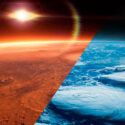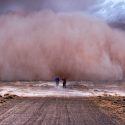Day X has arrived. Mount Fuji, Japan’s most famous volcano, is erupting for the first time in 300 years. It’s raining ash, lava and toxic gases down on the world’s largest city. What would it be like to witness this epic eruption? How much ash would cover Tokyo like a dark gray blanket? And how could this lead to a rise in China’s economy?
Mt. Fuji is located only 100 km (62 mi) from Tokyo, where 37 million people live. But this tall, cone-shaped giant isn’t just any mountain. It’s a stratovolcano. The last time Mt. Fuji erupted was over 300 years ago. When it blew up back in 1707, it blanketed the city in ash. This volcano sits on top of the Ring of Fire, the infamous and massive region of volcanic activity stretching around the Pacific Ocean.
And when it comes to the likelihood of Mt. Fuji erupting again, the scientific consensus is clear. It could happen soon. And it could be huge. Depending on where you were when Mt. Fuji pops, you could have a magnificent view of the eruption. You’d see a massive plume of ash rising from the peak. And you’d spy red magma pooling along its sides.
If you live on the outskirts of the city closest to Mt. Fuji, you could watch the lava flow slowly head toward your house, setting fires along the way. Within just three hours, you could be among the first 100,000 of people who need to be evacuated to other parts of the city. But even from a safer distance, the awesome view of the eruption would be concerning.
Ash would start to rain down on Tokyo. This would immediately suspend rail service. That’s because even a small amount of debris on the tracks could set trains off the rails. A layer of ash as thin as 0.2 cm (0.08 in) would make landing a plane safely nearly impossible. Departing flights would be grounded indefinitely. Besides low visibility, volcanic ash particles could cripple necessary navigational equipment.
And the heat of a plane’s engine could melt the ash, creating clumps inside it that could cause it to fail mid-flight. And you wouldn’t be able to drive either. As the layer of ash grew to a thickness of 2.5 cm (1 in), roads would become unusable to cars with two-wheel drive. The continuing pile-up of accidents and traffic jams would make the jobs of emergency first responders increasingly challenging.
Within 24 hours, the city would effectively shut down. Cell phone coverage would be disrupted. And with just 5 cm (2 in) of ash, thermal power plants would become inoperable. Many parts of the city would lose power. The ash would just keep falling for hours, days and possibly weeks. There could be ten times more debris than what fell after the Tōhoku earthquake and tsunami in 2011.
But that ash wouldn’t just be bad for trains, cars and electronics. It would be bad for you too. At first, you’d experience a runny nose, wheezing and coughing. The contaminated air would make your eyes red and itchy. If you inhaled too much, you could eventually develop silicosis. This condition could permanently scar and impair your lungs.
And not all districts of the city would fair equally. Winds would carry more ash to some and less to others. Some districts could be buried in an ash layer up to 30 cm (12 in) thick. Ordinary life would be nearly impossible to maintain in the aftermath of this eruption. With so many forms of transportation affected, many local supply chains would be cut off.
Tokyo would face shortages of food and medical supplies. Getting your usual clean water would also prove challenging due to contamination. Not only that, but the constant rain of ash could form natural dams along rivers, putting some areas at risk of flooding. The eruption of Mt. Fuji would force nearly one million people to be evacuated from their homes.
Globally, it would disrupt supply chains around the world since no ships would be able to navigate Tokyo Bay. Now, Japan is among the top-five exporters of goods around the world. And if Mt. Fuji set Japan’s electronics and automobile exports back, other countries could take their place. This could be huge for China and Germany, who are also big exporters of electronics worldwide. Japan could suffer billions of dollars in economic losses.
Sources
- “8 Fascinating Facts About Japan’s Mount Fuji”. Margherita Cole. 2022. mymodernmet.com.
- “Japanese Government Simulates What Would Happen If Mount Fuji Erupted”. Michael Thomsen. 2020. dailymail.co.uk.
- “Recent Progress Of Geophysical And Geological Studies Of Mt. Fuji Volcano, Japan”. Aoki, Yosuke, Kae Tsunematsu, and Mitsuhiro Yoshimoto. 2019. Earth-Science Reviews 194: 264-282. doi:10.1016/j.earscirev.2019.05.003. sciencedirect.com.
- “What Happens When A Plane Flies Through A Volcanic Ash Cloud?”. 2019. simpleflying.com.
- “Mount Fuji Eruption Would Paralyze Tokyo, Panel Warns | The Asahi Shimbun: Breaking News, Japan News And Analysis”. Ryo Yamagishi. 2020. asahi.com.


























